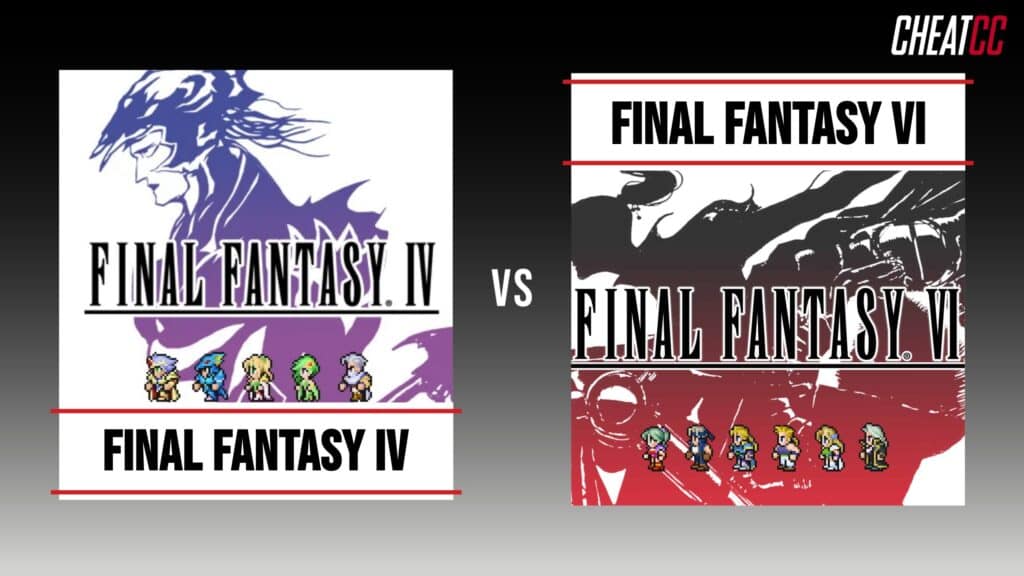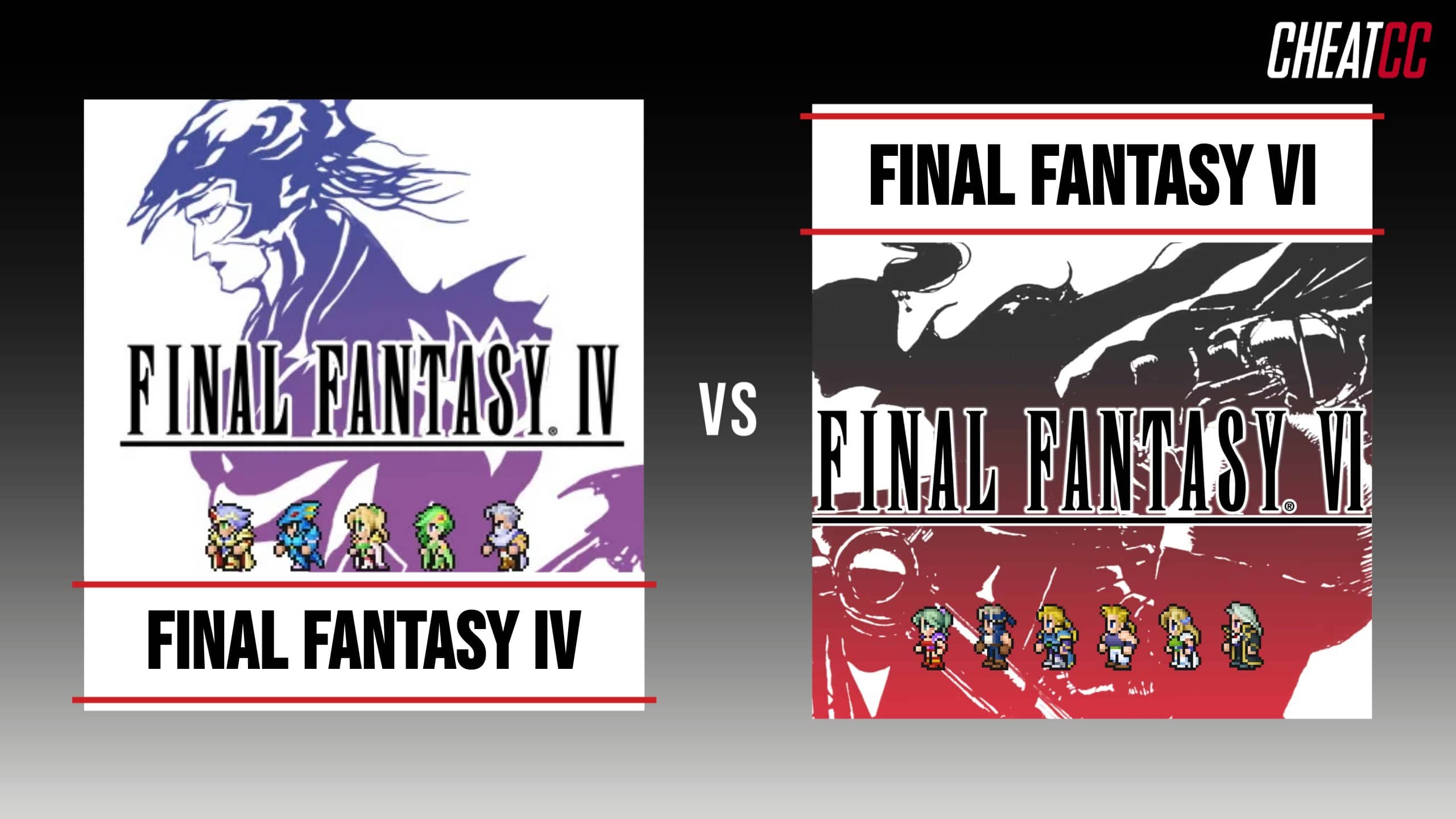Though most now know them by their official series numbering, many fans in the West who grew up with Final Fantasy during the NES and SNES-era remember Final Fantasy IV and Final Fantasy VI by their localization naming — Final Fantasy II and Final Fantasy III. Together, both of these titles would be responsible for introducing millions of players to the JRPG genre while simultaneously pushing the envelope for what’s capable in terms of video game storytelling. And, outside of both titles’ narrative accomplishments, each of these games holds its own as some of the most important and innovative games in the Final Fantasy franchise. Pitting Final Fantasy IV vs Final Fantasy VI is akin to forcing a parent to pick a favorite child, but it stands to reason that one has to reign supreme as the best SNES JRPG.
Final Fantasy IV would end up being the first “next-gen” game in the series, and there’s an argument to be made that Final Fantasy VI would then perfect Square’s formula it had been building to up to that point. Additionally, both titles are incredibly impactful in terms of their additions to the franchise, with combat mechanics and character progression systems from both making their way into several other series games. Ultimately, though, it is the stories and characters from each game that continue to endear them to fans as two of the best titles in the series, making it difficult to proclaim one a winner over the other as the superior SNES Final Fantasy.
Final Fantasy IV vs Final Fantasy VI: Side-by-Side Comparison

Releasing just a few years apart, both Final Fantasy IV and Final Fantasy VI represent the pinnacle of the 2D era of the franchise. Considering that the series would make its bold transition into 3D with Final Fantasy VII, these games also are two of the last great 2D JRPGs and the culmination of the franchise’s beginning years. North American players would get Final Fantasy IV as a launch title for the SNES in the form of Final Fantasy II, and Final Fantasy VI‘s arrival as Final Fantasy III would come right at the tail-end of the console’s lifespan. Together, both games stand as two of the best titles available for the SNES and two of Square’s best games during one of its more prolific periods.
| Characteristic | Final Fantasy IV | Final Fantasy VI |
|---|---|---|
| Release Year | 1991 | 1994 |
| Localization Title on SNES | Final Fantasy II | Final Fantasy III |
| Review Aggregate Score | 89% | 94% |
| Total Sales | 1.85 million units (SNES version) | 3.42 million units (SNES version) |
| Director | Hironobu Sakaguchi | Yoshinori Kitase |
| Number of Party Members | 12 | 14 |
| New Introductions to Series | ATB System, Characters with Set Classes, Character and World Building | Ensemble Cast rather than Main Character, Espers & Magicite, Open-World progression in second half |
| How Long to Beat | 24.5 Hours | 40.5 Hours |
| Remakes/Remasters/Ports | 7 Ports/Remasters, 1 Remake | 7 Ports/Remasters |
| Sequels | Final Fantasy IV: The After Years | N/A |
Final Fantasy IV vs Final Fantasy VI: 5 Must-Know Facts
Here are 5 must-know facts when comparing Final Fantasy IV to Final Fantasy VI:
- Both Final Fantasy IV and Final Fantasy VI greatly expand on the storytelling and character/world-building of the series, but Final Fantasy IV is the first game to truly elevate these aspects. That said, Final Fantasy VI‘s story continually ranks as one of the best in the series.
- Rather than focus on a central protagonist that acts as the game’s main character, Final Fantasy VI utilizes the idea of an ensemble cast for its heroes, with each of them gaining the spotlight at various points in the narrative.
- Both of these Final Fantasy titles bring innovations to the series that have long-lasting ramifications. Final Fantasy IV doesn’t just improve the storytelling and character building over previous games, it also introduces the ATB system that revolutionizes RPGs moving forward.
- Despite selling incredibly well in Japan, Final Fantasy IV would fail to move more than 500k copies in the West. Surprisingly, Final Fantasy VI would end up being much more successful both critically and commercially.
- Final Fantasy VI is the first game in the series to feature direction from Yoshinori Kitase. Kitase would not only go on to direct the now-legendary Final Fantasy VII, he also currently serves as the franchise’s brand manager and a VP at Square Enix.
Final Fantasy IV vs Final Fantasy VI: Gameplay & Story Focus
The Final Fantasy series has always been synonymous with elevating the art of storytelling within games, but the first game in the series to really hammer this point home is Final Fantasy IV. Final Fantasy IV‘s story features a cast of fan-favorite characters as well as a series-best narrative centering around redemption and family. While Final Fantasy VI‘s story is incredible in its own right and features arguably the best antagonist in the history of the series, the focus of the title is inarguably in its gameplay, which features some of the best mechanics of any game in the series. In comparison, Final Fantasy IV is mostly a classic JRPG with a greater emphasis on story rather than truly innovating in terms of its various gameplay elements.
Final Fantasy IV vs Final Fantasy VI: Ensemble Casts
Though there are 12 different playable characters in Final Fantasy IV, the story mainly centers around the Dark Knight-turned-Paladin Cecil, his girlfriend Rosa, and best friend-turned-enemy Kain. At a certain point in the story, the player gains the party of 5 heroes that will carry them through the rest of the game and the focus never shifts off of these 5 heroes. Conversely, Final Fantasy VI features 14 different playable heroes, and with only one or two exceptions, each of these characters gets a chance to shine within the spotlight of the narrative. Though there’s an argument to be made that the game’s main character is Terra, one could just as easily argue that it’s Locke, Celes, or the twin brothers Sabin and Edgar who act as the game’s protagonists. This “ensemble cast” approach is unique to Final Fantasy VI.
Final Fantasy IV vs Final Fantasy VI: Series Innovations
First and foremost, Final Fantasy IV makes one of the most important contributions to both the series and the genre as a whole via the Active Time Battle (ATB) System. Rather than have enemies and characters act in turns according to their agility or speed stats, enemies can now act while characters wait for an ATB gauge to fill, creating a sense of urgency and necessitating strategy in what’s otherwise standard menu-based RPG combat. Similarly, Final Fantasy VI provides some worthwhile iterations on the series’ mechanics through the Espers & Magicite system, which allows any character to not just learn magic but also master dozens of spells and control their stat growth in the process. Dedicated players can bring every character up to level 99 with maxed-out stats and every spell in their arsenal.
Final Fantasy IV vs Final Fantasy VI: Sales and Reception
Final Fantasy IV‘s arrival as a launch title for the Western release of the Super Famicom (the SNES) would see it sell fairly well in comparison to other JRPGs, but it would end up having some of the weaker sales of a localized release in comparison to later series entries. Thanks to some clever marketing through print ads and commercials, Final Fantasy VI would end up being one of the best-selling SNES games of the year, as well as the 12th best-selling SNES game of all time. Similarly, the critical scores of Final Fantasy VI place it at 94% on average, which also happens to outshine Final Fantasy IV‘s review aggregate score of 89%. Despite many fans holding a fond place in their hearts for Final Fantasy IV/Final Fantasy II, the truth is that Final Fantasy VI is the better-performing title on all fronts.
Bottom Line
Final Fantasy VI would end up marking a significant turning point for the Final Fantasy series. As both the last 2D game in the franchise and the last game in Square’s long and fruitful partnership with Nintendo, the 6th Final Fantasy game is an incredible culmination of the series’ first 7 years and the end of an era. That Yoshinori Kitase would direct both Final Fantasy VI and Final Fantasy VII is telling, seeing the Square luminary close out one chapter for the franchise while kickstarting the next.
In terms of its critical and commercial reception, as well as its importance to the franchise and the series as a whole, there’s little denying that Final Fantasy VI represents both the best SNES-era Final Fantasy and perhaps the best JRPG ever made. While the tale at the heart of Final Fantasy IV has a special place in many fans’ hearts, Final Fantasy VI is arguably the superior game.
